New Utrecht Reformed Dutch Church Cemetery
Introduction
Text-to-speech Audio
The cemetery in Bensonhurst at 16th Ave. between 84th and 85th streets is one of the oldest in New York City. The New Utrecht Reformed Dutch Church Cemetery was established in 1653 to 1654 as the New Utrecht Burial Ground. The New Utrecht Reformed Dutch Church wasn't established until 1677, and then took over the burial ground. The one-acre cemetery contains gravestones with readable dates from about 1781 to the twentieth century. A newer church building built in 1898 (now Metropolitan Baptist Church) stands next to the cemetery where a former building was constructed in 1700 for New Utrecht Reformed Church. The cemetery became a New York City landmark and was listed in the National Register in 1998. Entrance to the cemetery through the chain link fence is on 85th St. off of 16th Ave; there is an historic sign in the cemetery at the 16th Ave./ 84th St. corner. The cemetery is not open to the public except during occasional tours by Friends of Historic New Utrecht.
Images
New Utrecht Reformed Dutch Church Cemetery (NURDCC), ca. 1997 photo by Carl Forster (Kurshan & NYC LPC 1998)
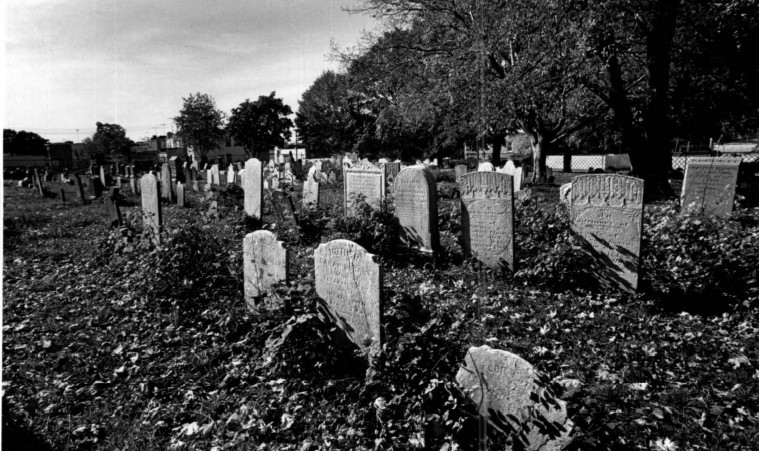
Gravestone of 43-year-old Rulif Van Nuyse (died 1830s) in NURDCC, Foster ca. 1997 (Kurshan & NYC LPC 1998)
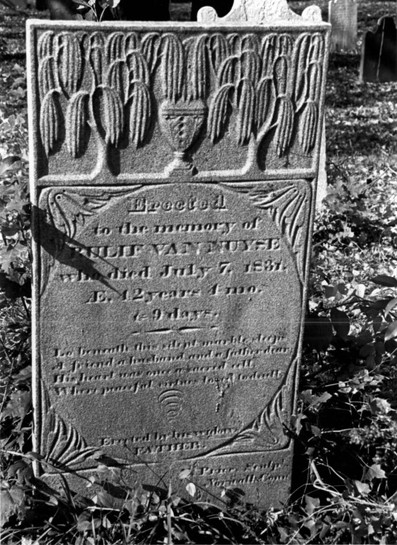
Gravemarkers for Sarah V. Pelt Duryee (left, died 1813 age 62) & husband Abraham Duryee (d. 1814 age 70), Foster ca. 1997
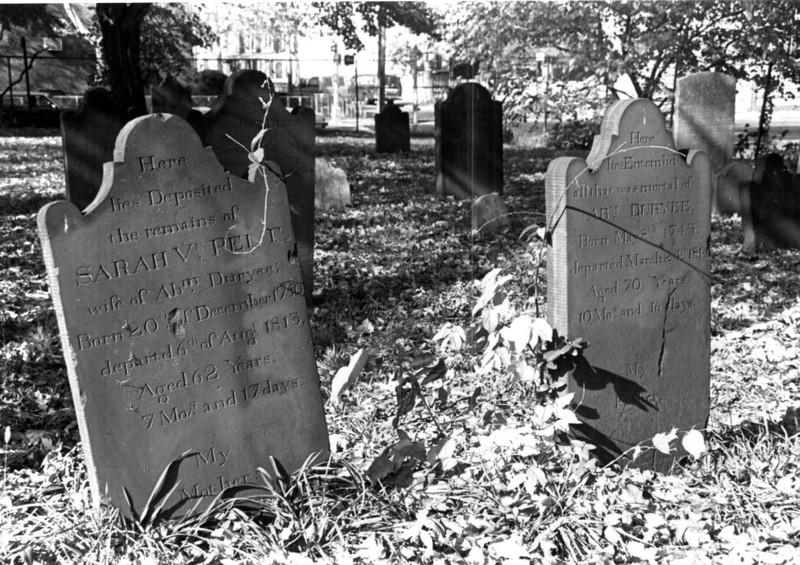
1922 photo of New Utrecht Cemetery & St. John's German Evangelic Church, from corner of 84th/ 16th (NYPL)
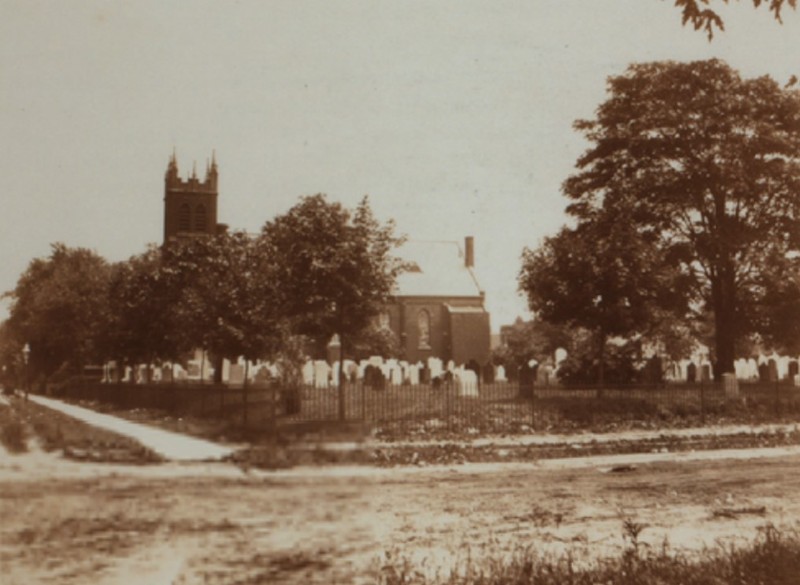
New Utrecht Reformed Cemetery (purple arrow) on 1890 map; N.U. Ref. Church upper right (Robinson p. 16)
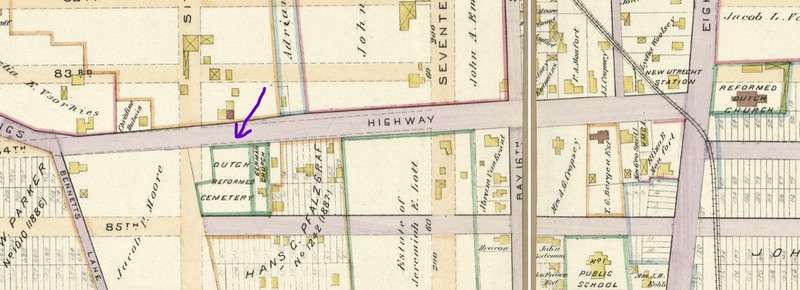
Backstory and Context
Text-to-speech Audio
New Utrecht was settled by the Dutch West India Company's Cornelius Van Werckhoven, and after his death, by Jacques Cortelyou. In the early days of the Dutch Town of New Utrecht (covering present-day Bay Ridge, Borough Park, Bensonhurst, and Bath Beach), farm families typically buried their dead in a family cemetery on their farm. Some of the interments were later moved to the cemetery established in the 1650s on the outskirts of the Village of New Utrecht. The cemetery was on the Village of New Utrecht's main street (Kings Highway, now 84th St.).
In 1700, a church was built next to the New Utrecht Reformed Church Cemetery along 84th St.; this former building was octagonal with a tall spire. Before that, the parishioners traveled to Reformed Churches in Flatbush or Gravesend for services. The area was occupied by the British during the Revolutionary War, who reportedly lived in the church and used the gravemarkers in this cemetery for target practice.
A newer church building (St. John's German Evangelical Church in 1920s; Metropolitan Baptist Church now) stands in the location of the 1700 church, east of the cemetery. A new building for New Utrecht Reformed Church is located on 84th St. east of 18th Ave. (also a Clio entry) and was built in the late 1820s using stones from the previous (1700) church. The cemetery became a New York City landmark and was listed in the National Register in 1998, along with the parish house (built 1892) of the standing church; the church is a National Historic Landmark (1966) and was added to the National Register in 1980.
Highlights of the cemetery include a communal, unmarked grave of Revolutionary War soldiers and an area near the intersection of 84th and 16th where many Afican-Americans (free and enslaved) were buried. Although the Daughters of the American Revolution erected a monument here in 1916 to local Revolutionary War General Nathaniel Woodhull, the general died near here after being wounded in the Battle of Long Island (Battle of Brooklyn) and was buried elsewhere on Long Island. The cemetery contains about 1,300 burials. Most of the early gravemarkers are upright tablets of red sandstone or brownstone. Limestone and marble became more commonly used in the cemetery's nineteenth-century gravestones, and are susceptible to erosion from environmental factors like acid rain. Granite became a more popular material by the late nineteenth century, and is more durable.
New Utrecht Reformed Church and an organization called Friends of Historic New Utrecht have organized volunteer groups to clean up and restore the cemetery over the past couple decades. They had their work cut out for them in 2003 after Hurricane Isabel toppled a number of large trees in the graveyard. Earlier, a tall obelisk monument to two doctors who died fighting a yellow fever epidemic in 1910 was knocked off its base by a falling tree limb during Hurrican Floyd (1999). While new burials are rare now, they do happen once in a while.
Sources
Forgotten New York staff. New Utrecht Cemetery, Forgotten New York. November 1st 2021. Accessed April 18th 2022. https://forgotten-ny.com/2021/06/new-utrecht-cemetery/.
Kurshan, Virginia. NYC Landmarks Preservation Commission. New Utrecht Reformed Dutch Church Cemetery, Brooklyn, LP-1978. NYC landmarks. New York, NY. NYC Government, 1998.
La Marca, Vincent. 'Liberty Weekend' May 31-June 1 on historic Bensonhurst church grounds, News - New Utrecht Reformed Church. Press release. May 22nd 2008. Accessed April 18th 2022. http://www.newutrechtchurch.org/news/archives/2008_05_01_archive.html.
New Utrecht Reformed Church. Church History, New Utrecht Reformed Church. Accessed April 18th 2022. http://www.newutrechtchurch.org/history.htm.
Silberstein, Rachel. A Walk Through Forgotten Brooklyn at Old New Utrecht Cemetery, Bklyner: Bensonhurst History. May 6th 2015. Accessed April 18th 2022. https://bklyner.com/a-walk-through-forgotten-brooklyn-at-old-new-utrecht-cemetery-bensonhurst/.
NYC Landmarks Preservation Commission designation report 1988 p. 1
NYC LPC designation report 1998 p. 8
NYC LPC designation report 1998 p. 10
Eugene L. Armbruster Collection, New York Public Library (NYPL): https://digitalcollections.nypl.org/items/510d47dc-c365-a3d9-e040-e00a18064a99
Library of Congress (LOC): https://www.loc.gov/item/2011594778/
